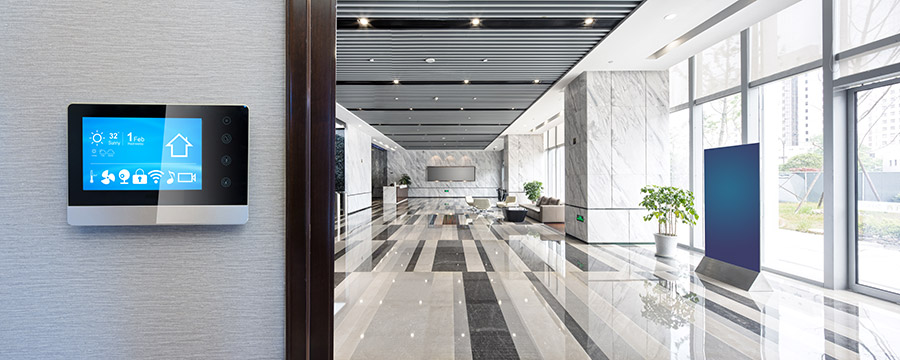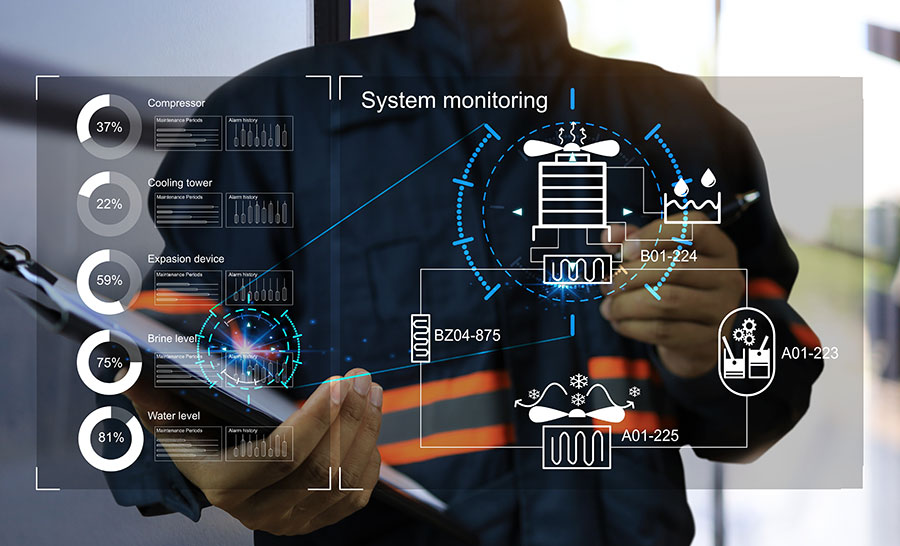IoT Technology for Efficient Operations in Facility Management
In the realm of facility management, the advent of Internet of Things (IoT) technology marks a significant turning point, steering organisations towards unprecedented levels of efficiency and effectiveness. IoT, a network of connected devices that communicate data over the internet, is a disruptive technology enabling a seamless connection between people, processes, and systems.
Facility management, the process of coordinating the physical workplace with the people and work of an organisation, is integral to maintaining and enhancing the quality of life within facilities and improving productivity.
Incorporating IoT technology into facility management brings transformative possibilities, streamlining operations, reducing costs, improving safety and security, and enhancing the user experience. This article delves into the intricacies of IoT in facility management, from its evolution, components, use cases, benefits, the role in real-time analytics to future prospects.
The Evolution of Facility Management through IoT Technology
Pre-IoT era in Facility Management
Before the IoT’s advent, facility management involved manual operations, including record keeping, maintenance, space management, and security. The process was often time-consuming, error-prone, and labour-intensive. Also, the lack of real-time data analysis made predictive maintenance and immediate decision-making impossible.
The Emergence of IoT in Facility Management
The introduction of IoT technology significantly changed the facility management landscape. IoT devices started monitoring and controlling systems such as lighting, heating, ventilation and airconditioning (HVAC), and security, allowing for real-time data collection and analysis, remote access, and automation of processes. This era brought significant improvements in efficiency, productivity, and cost-effectiveness in facility operations.
Current State and Advancements in the Integration of IoT in Facility Management
Currently, IoT technology in facility management is experiencing continual advancements. There is an increasing adoption of AI and machine learning for predictive analysis, automation of complex processes, and personalised user experiences. The integration of IoT with other emerging technologies like 5G and edge computing is enhancing connectivity and data processing speeds. The ability to extract insights from big data allows for better decision-making, predictive maintenance, and optimisation of resources.
Understanding the Capabilities of 5G
5G, the fifth-generation technology standard for broadband cellular networks, delivers unprecedented data speeds, low latency, and improved connectivity, paving the way for innovative applications in IoT, autonomous vehicles, and smart cities.
Harnessing Edge Computing
Edge computing is a cutting-edge technology architecture that decentralises data processing, pushing it closer to the source of data generation. By reducing the distance data travels, it significantly reduces latency and bandwidth usage, enhancing speed and efficiency. This technology is a game changer for IoT, autonomous vehicles, and real-time analytics, allowing faster and more effective decision-making directly at the ‘edge’ of the network.
Core Components of IoT in Facility Management

IoT Devices: Sensors and Actuators
Sensors and actuators are the building blocks of IoT in facility management. Sensors monitor changes in the environment, such as temperature, light, and motion, and relay this data to a central system or cloud. Actuators, on the other hand, execute actions based on the information received, controlling systems such as lighting, HVAC, and security.
Connectivity: Networks and Protocols
In the realm of IoT, establishing seamless and dependable connectivity stands as a critical foundation for efficient communication between devices. The backbone for data transmission is fortified by an array of diverse networks and protocols. These encompass the long-range and power-efficient LoRaWAN, alongside the versatile and widely-used mobile IoT networks, encompassing 2G, 3G, 4G, and cutting-edge 5G. Additionally, the emergence of LTE-M and NB-IoT technologies further enriches the ecosystem, offering specialised solutions to cater to specific IoT use cases. Emphasising the significance of robust and reliable connectivity, these networks and protocols play an indispensable role in ensuring smooth data exchange for business within the IoT landscape.
Platforms: IoT Management Platforms
IoT management platforms serve as vital intermediaries, bridging the gap between hardware and application layers. These platforms play a pivotal role by seamlessly integrating, managing, and analysing data from a diverse range of devices. With their capabilities, they unlock actionable insights, enable remote control, and empower process automation. Among the leading platforms in this space, melita.io stands out, catering to both mobile and LoRaWAN IoT applications, offering a comprehensive suite of functionalities and more.
One of the standout features of the melita.io IoT platform is its robust security framework, featuring a stringent two-factor authentication process (2FA), ensuring data integrity and protection against unauthorised access.
A key highlight of melita.io mobile IoT platform is its innovative triggers function. This intelligent system constantly monitors the SIMs behaviour, keeping a vigilant eye on operations. In the event of any unexpected behaviour, the platform automatically initiates specific functions, enhancing the platform’s responsiveness and minimising potential disruptions.
Through its seamless integration of features, robust security measures, and the automation prowess of its triggers function, the melita.io IoT management platform truly stands as a powerful and reliable tool, empowering businesses with efficient data management and control over their IoT ecosystems.
Security: Ensuring Data Integrity and Privacy
In the era of digitalisation, data security and privacy are paramount. IoT systems in facility management must incorporate robust security measures, including encryption, secure access controls, and regular updates to prevent data breaches and ensure data integrity.
Use Cases: IoT for Efficient Operations in Facility Management
IoT technology plays a vital role in various aspects of facility management, leading to enhanced efficiency and productivity:
Building Energy Management: IoT sensors monitor and control energy consumption in real-time, reducing energy waste and promoting sustainability.
Security and Access Control: IoT enables automated and remote control of security systems, ensuring secure access and immediate response to security threats.
Predictive Maintenance: IoT devices can monitor equipment health and predict failures, reducing downtime and maintenance costs.
Space Utilisation and Smart Offices: IoT allows for real-time monitoring and optimisation of space utilisation, improving employee productivity and wellbeing.
Smart Parking: IoT enables efficient management of parking spaces, reducing congestion and enhancing user experience.
Environment Monitoring and Control: IoT devices can monitor and regulate environmental parameters like temperature, humidity, and air quality, improving the comfort and health of occupants.
Benefits of Implementing IoT in Facility Management
Implementing IoT technology in facility management brings several significant benefits:
Increased Operational Efficiency: IoT enhances automation and real-time monitoring, reducing manual tasks and errors, thus increasing efficiency.
Cost Reduction: IoT enables predictive maintenance and energy management, leading to significant cost savings.
Enhanced Safety and Security: IoT improves security systems and emergency response, enhancing the safety and security of facilities.
Improved User Experience: IoT can personalise user experiences, enhance comfort and convenience, and improve productivity and wellbeing.
Sustainable and Environment-friendly Practices: IoT aids in energy management and promotes sustainability.
The Role of IoT in Real-time Data Analytics in Facility Management

The Importance of Real-time Data Analytics
Real-time data analysis is critical in facility management as it allows for immediate decision-making, predictive maintenance, and personalised user experiences. It eliminates guesswork, reduces downtime, and enhances efficiency and productivity.
How IoT enables real-time Analytics
IoT devices collect a vast amount of data from various sources in real-time. This data, when analysed, provides valuable insights into various aspects of facility management, enabling informed decision-making, immediate responses, and proactive actions.
The Impacts of Real-time Data on Decision-making Processes in Facility Management
Real-time data analysis enables facility managers to make informed decisions regarding maintenance, energy management, space utilisation, and security. It allows for predictive maintenance, reducing downtime, and cost. It also aids in optimising resource utilisation, improving efficiency and productivity.
Overcoming Challenges in Implementing IoT in Facility Management
While IoT brings numerous benefits, implementing it in facility management comes with some challenges:
Integration with existing infrastructure: Integrating IoT with existing systems can be complex and time-consuming. It requires careful planning, expert knowledge, and adequate resources.
To address this situation effectively, it’s worth noting that melita.io presents a valuable solution with its API offerings for seamless data integration. Whether you are working with LoRaWAN or mobile IoT systems, melita.io have you covered, providing dedicated APIs to facilitate smooth and efficient data communication and exchange.
By leveraging these APIs, businesses can seamlessly integrate melita.io IoT system into their existing infrastructure, enabling a cohesive flow of data between their IoT devices and other applications or platforms. This integration opens up a world of possibilities, empowering users to extract meaningful insights, optimise processes, and make data-driven decisions, thereby maximising the value of their IoT investments.
API’s exist for both LoRaWAN and mobile IoT systems. Learn more melita.io features and plans here.
Data security and privacy: With the increasing use of IoT, data breaches are a growing concern. Implementing robust security measures is crucial to ensure data integrity and privacy.
Budget constraints and ROI considerations: The initial investment in IoT can be substantial. Businesses need to consider the return on investment and long-term benefits.
Need for continuous learning and adapting to technological changes: IoT is rapidly evolving, requiring businesses to stay updated and adapt to technological changes.
Looking Forward: The Future of IoT in Facility Management
The Role of AI and Machine Learning in Future IoT Applications
Artificial Intelligence (AI) and machine learning will play a significant role in the future of IoT in facility management. They will enhance predictive analysis, automate complex processes, and personalise user experiences.
Understanding AI
AI, or Artificial Intelligence, refers to the simulation of human intelligence processes by machines, particularly computer systems. This involves learning from data, reasoning to reach conclusions, understanding natural language, and even self-correction. AI technologies can perform tasks ranging from simple, rule-based operations to complex decision-making, underpinning transformative technologies like autonomous vehicles, personalised recommendation systems, and advanced medical diagnostics.
Machine Learning: The Driving Force Behind Modern Digital Interactions
Machine learning is a dynamic subset of AI that empowers computer systems to learn and improve from experience, without being explicitly programmed. It harnesses algorithms that can sift through, learn from, and make decisions based on data. Over time, these systems “learn” to predict outcomes or enhance decision-making. The beauty of machine learning lies in its ability to adapt: as new data comes in, the algorithms self-adjust to produce more accurate results.
Integration of Other Emerging Technologies (5G, Edge Computing)
The integration of IoT with 5G will enhance connectivity and data transmission speeds. Edge computing will enable faster data processing at the source, reducing latency and improving efficiency.
Predicted Trends and Developments in IoT for Facility Management
The future will see an increasing adoption of IoT in facility management, driven by advancements in AI, machine learning, 5G, and edge computing. IoT will further enhance efficiency, productivity, and user experience while promoting sustainability.
In conclusion, IoT technology is a game-changer in facility management. It provides unprecedented opportunities to improve efficiency, productivity, safety, and user experience. However, businesses need to understand their specific needs, consider the challenges, and make informed decisions when implementing IoT in facility management. Despite the challenges, the future of IoT in facility management looks promising, and early adopters will undoubtedly gain a competitive edge.
Get started now with our IoT SIM plans
Our competitive data rates are designed for businesses operating across Europe, the UK, the USA, China and beyond — without any additional roaming fees.
IoT SIM
€5 per GB pay per use in over 60 countries
€1 per SIM per month
Lifetime IoT SIM
1 GB, 100 SMS
10 years for a one-time fee of €10
